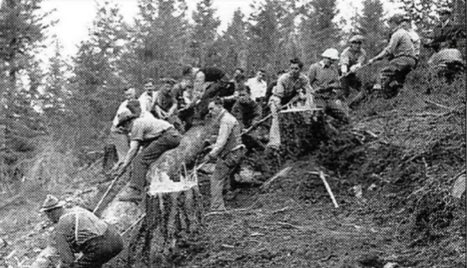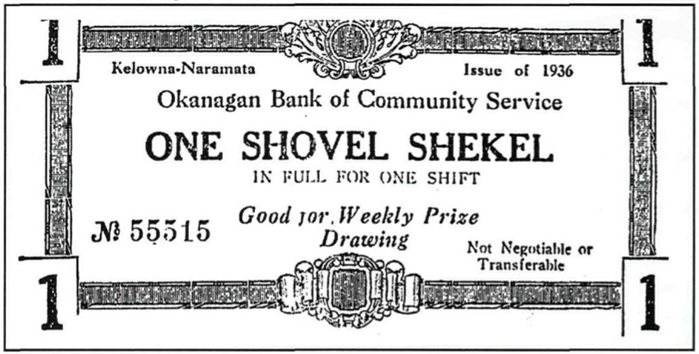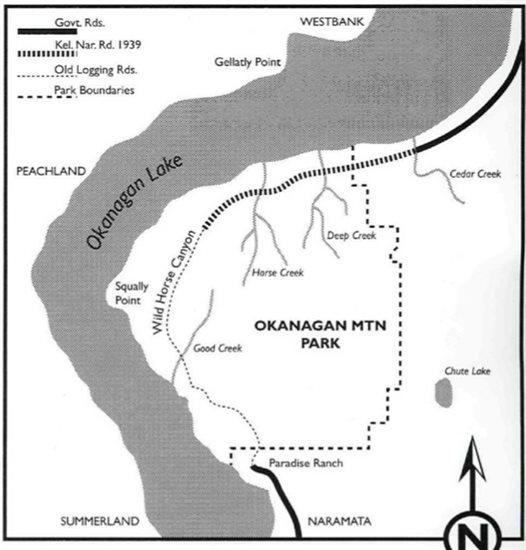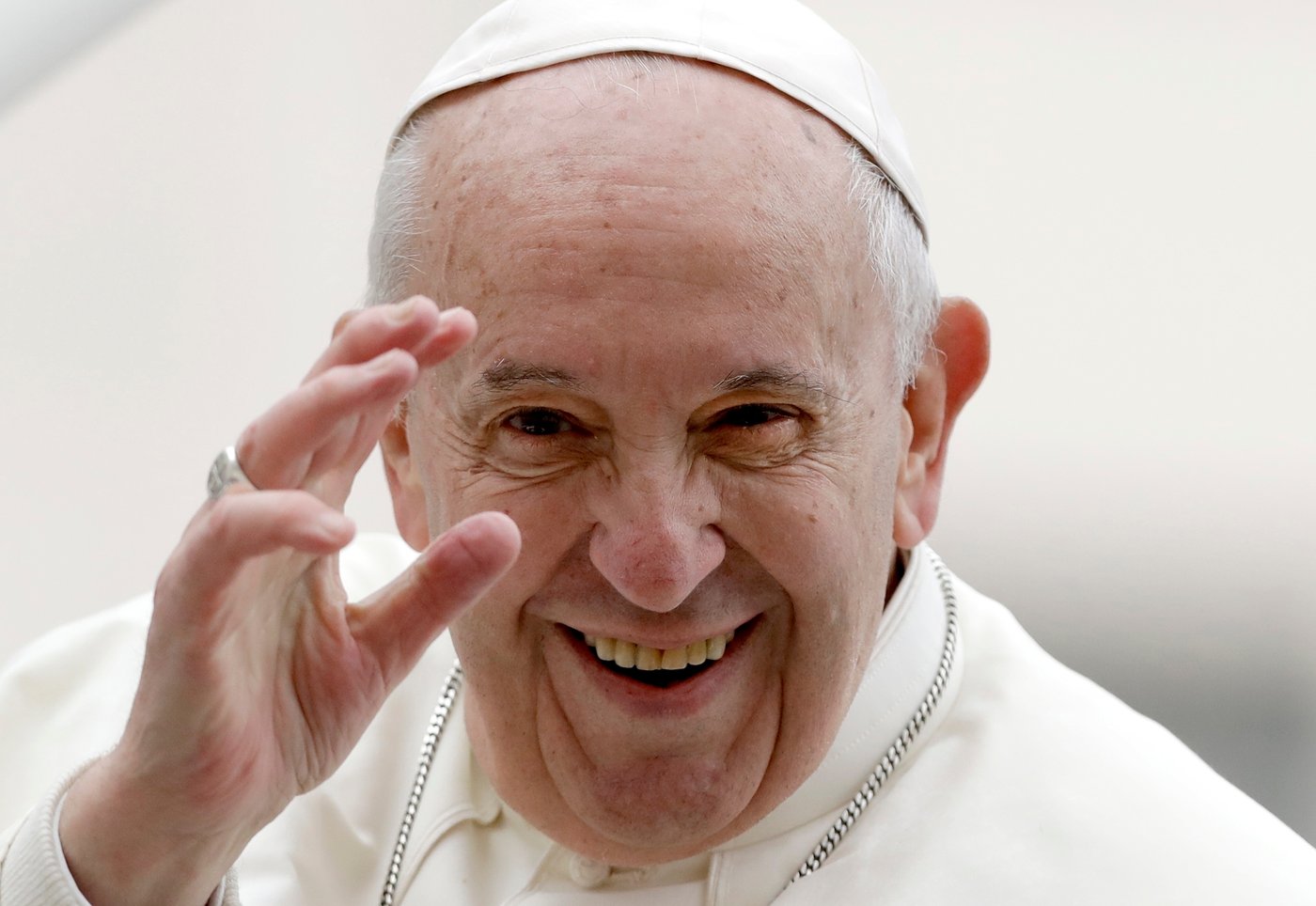The Kelowna to Naramata road that never was

There has been talk for decades about a second crossing of Okanagan Lake with a bypass highway around West Kelowna and Kelowna.
The region’s latest transportation plan has vetoed that idea but there was a time when work actually began on a road that would bypass the lake itself.
The plan was for people to drive from Kelowna to Naramata through what is now Okanagan Mountain Park.
“In retrospect, if the road from Kelowna to Naramata had been completed by the highways department and brought up to proper standards, would the Okanagan Bridge have been built and in use by 1958?” Hume M. Powley pondered in 1999 in his story of the road project in the 63rd Report of the Okanagan Historical Society.
He was one of the men who laboured on the road in the late 1930s.
That was a time when travel in the Okanagan was mainly by boat and almost a decade after the first car ferry started plying Okanagan Lake between Kelowna and Westbank.
Called the MV Westbank-Kelowna, the ferry started service in 1927 as the first government-run ferry on the lake. Before that vehicles had to be barged across.
The MV Westbank-Kelowna carried 15 vehicles but as demand grew and service became more unreliable, often stopping all together when the lake froze over in winter, it was dubbed the MV Hold Up.
“The Kelowna Courier and Orchardist, now called The Daily Courier, in its March 5, 1936 weekly issue ran a scathing editorial deploring the ferry situation,” Powley wrote. “The editorial went on to back a suggestion by five prominent Kelowna citizens that a road be built on the east side of Okanagan Lake from Kelowna to Naramata to connect with the Penticton-Paradise Ranch road already in use.”
READ MORE: iN PHOTOS: Treasure trove of historical depictions of life from Kamloops to Osoyoos
Later that spring the Minister of Public Works came to Kelowna and, after some lobbying, said he would think about funding a road.
“However, in July 1936, when the highway appropriations were announced, his memory must have failed him as no money was allotted to help with the construction of any road on the east side of Okanagan Lake south of Kelowna,” Powley wrote.
Five men launched the movement to build the road with volunteer labour: Sam Miller, H. V. Craig, Reg. G. Rutherford, Frank Groves, and I.V. Newman.
They were able to drive up an old volunteer-built road to Chute Lake then hiked along the West Kootenay power line to Paradise Ranch, north of Naramata.
They decided the power line had too many steep grades and opted for a route that roughly followed the old Penticton Trail.
That was the route followed by Father Pandosy when he arrived in the area in 1859 but, by 1936, was little used anymore.
“On Sunday, Sept. 27, 1936, 33 volunteers armed with picks, shovels, rakes, axes and crowbars started work on the section from near Cedar Creek south to link up with the Penticton Trail,” Powley wrote.
On Oct. 1, the newspaper proclaimed: “First Mile of East Side Road is Complete – On the Naramata.”
While they knew that such progress was not going to be standard because of all the rock blasting that was needed, it was a great start. The Board of Trade called for volunteers to help on the road Thursday afternoons and Sundays.
“The response was great: nearly 90 people showed up at the next work party,” Powley wrote. “As well, three teams of horses arrived with scrapers and they, along with other workers, fashioned a good grade on the northern end. Overall progress was slowed, however, when the crews working farther south encountered increasing rock stretches.”
The Okanagan Highway Association was incorporated to accept donations for things like blasting powder and detonators.
“Another innovation introduced to volunteers during the road work was the Shovel Shekel,” Powley wrote. “Two shekels were issued for each day's work, one for the morning shift and one for the afternoon and a weekly draw was held for donated prizes. Shekel number 55159 was the first lucky ticket drawn and the winner took home a large glass bottle of tobacco put up by George McKenzie ‘The Grocer.’”
“The Naramata volunteer road project began to draw favourable editorial comment in papers in throughout BC and across Canada. Issuing Shovel Shekels drew excellent reviews in the Halifax Herald and the Toronto Globe and Mail.”
The 16-mile project was divided into three sections.
One went from Cedar Creek for six miles to the big canyon (Wildhorse Canyon). Then there was an old logging road for five miles through the canyon followed by another five miles to Paradise Ranch.
Different crews worked on different sections of the road. A Winfield group, for example, built the bridge across Deep Creek naming it, naturally, Winfield Bridge.
“It was hoped that 200 men would turn up on Sunday, Oct. 25, 1936, to try to finish the section near Deep Creek,” Powley wrote. “Instead, only 75 volunteers presented themselves but a good day's work was accomplished. A log cabin was built near Deep Creek, complete with windows, to store supplies and a sign bearing the name Kelata was proudly hung over the door.”
It wasn’t just the men joining in. Women would make the trek to feed them lunch and tea.
Not mentioned in Powley’s account, is the contribution of school children.
“When I was about 15 years old we high school students would meet every Saturday morning and we would be driven out to work on the road,” Ella Reid Sinkewicz wrote in a letter to historian Dorothy Zoellner published in the Daily Courier in 2003 when she was 82 years old.
“We would have a piece of land laid out for us marked with a long length of wire and we would have to roll rocks down to even it out. Then Francis Thornloe would come with his truck and away we’d go with our shovels and get a load of dirt. We would unload it onto our stretch of the road and level it off.
“The part we worked on, very near the beginning of the road, was called High School Heights. Sadly, when the map was drawn, it wasn’t in it. I hope that someone can add it to the map, as we took great pride in our adventure and for it, we received ‘shovel shekels’ as payment for work done.”
Work shut down for the year on Nov. 5.
READ MORE: Spiritualists, Japanese warlords and mispronounced words: Where the Okunaakan got its names
April 12 to 17 of 1937 was proclaimed “On To Naramata Week” followed by a banquet on April 22 at the Royal Anne Hotel.
“Okanagan Lake having frozen over two months before, the fact there was no ferry service served to keep the Naramata road project on centre stage,” Powley wrote.
Work resumed in May and continued slowly through the summer.
“When work resumed on April 24, 1938, it was found that the road had come through the winter and spring runoff with flying colours,” Powley wrote. “However, in June the public works department in Victoria announced that tenders would be called for a new and larger ferry to replace MS Hold Up.”
The new ferry was the MV Pendozi, with twice the car carrying capacity.
That didn’t slow work down and, by the end of the year, the road was completed to the entrance of the big canyon where a large slough posed the threat of flooding during high water years.
That was the end of the project for that year and, essentially, for all time.
Some work was done in 1939 but the new ferry was launched in June and the country started gearing up for World War Two, which Canada entered in September.
“Hopes of continuing the project ended when rearmament preparations for WWII made it impossible to obtain dynamite for such low-priority causes as the Kelowna-Naramata road,” Powley said
- This story was updated at 7:05 a.m. June 5, 2023 to correct the location of Paradise Ranch.
To contact a reporter for this story, email Rob Munro or call 250-808-0143 or email the editor. You can also submit photos, videos or news tips to the newsroom and be entered to win a monthly prize draw.
We welcome your comments and opinions on our stories but play nice. We won't censor or delete comments unless they contain off-topic statements or links, unnecessary vulgarity, false facts, spam or obviously fake profiles. If you have any concerns about what you see in comments, email the editor in the link above.






